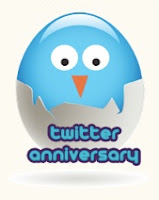 |
| Happy Twitterversary. |
Today marks the one year anniversary of
Sean Garrett’s tenure as a Vice President of Communications. I was hoping to be a part of his team by now, but I’ve yet to make that a reality. It seems not-so-long-ago when friends were sharing open positions at a little start up in SOMA called Twitter. One offer was for a “Founder Associate.” Another was for a “Communications Associate.”
“Twitter is defining a new form of communication that is touching people’s lives across the world. We are small but well-funded and building a company to last. We are currently a team of 25 and looking for a few key people who will help take us to the next level.”
Twitter Founder Associate Job Description- Jobscore, 16 March 2009
Both positions seemed exciting, new, and unknown, but I was happy
where I was, and had no reason to leave. I was
already using Twitter—a lot. I was even
using it in my job. And even though I was a tireless advocate of its uses, potential, and evolution as a new communications platform, working there never seemed to make sense. All that changed once It's power to do good started to become more apparent to me.
It’s no secret that when I first moved out to California my goal was to join the forces of good at
Google.org. But as their
priorities changed, I found myself looking for somewhere else to aim my corporate social responsibility ambitions. I was working for the
Intel Education Foundation, but I knew that their focus—and funding—was limited. I longed to find a place to make a greater impact.
Other jobs have come and gone, most with non-profits, and some simply to fund an increasingly more expensive San Francisco existence, but I still feel driven to put my knowledge to use helping others. That doesn’t mean that
Twitter’s recent rejection of my advances to join the flock hurts any less; it just means that I need to fine-tune my focus for getting in the door. So my new aim is to harness my interests to bridge the gaps between Twitter’s Communication, Media, and Philanthropic teams.
The details of my focus, what I can offer, and the strategy for getting there are still emerging. But they all start with finishing the
application I have been trying to build on the Twitter API for the last few months. Harnessing information and redirecting it into action remains my new creation’s goal. As we’ve seen in northern Africa, information is at its most meaningful when it’s acted upon. So I hope to create an end product which will make that divide much smaller.
As usual, I’ll keep you updated on things as they progress. And I’m sure I’ll post a distraction or two about
Twitter news in the meanwhile. But I’ll keep building. And writing. And trying to
join the flock, while looking for you on the ‘morrow, on the Web.








